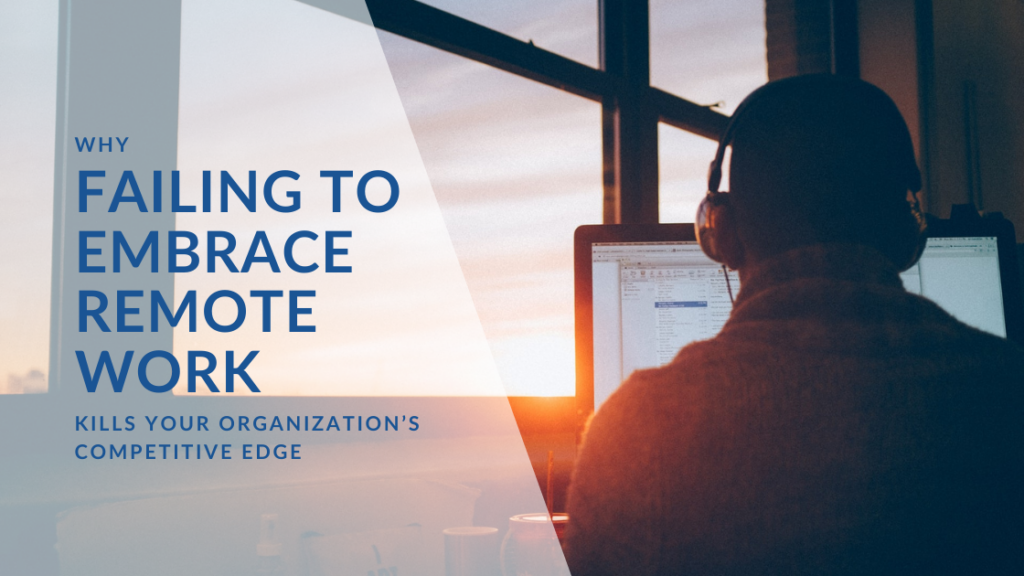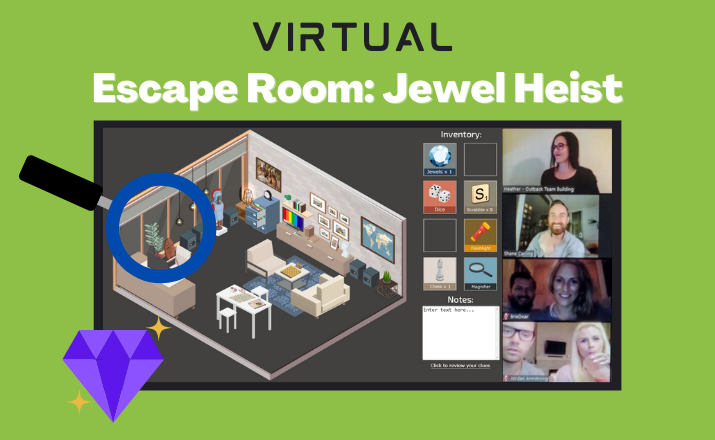Why Failing to Embrace Remote Work Kills Your Organization’s Competitive Edge

As The Great Resignation shakes up the working world, offering remote or hybrid work is becoming a make-or-break point for organizations.
There’s no easy way to say this, so we’ll just go ahead and say it: times are changing and organizations that fail to adapt are going to suffer for it.
Right now, we’re in the middle of a massive shake-up to the employment landscape. Some are calling it The Great Resignation. Others are calling it The Big Quit. But whatever you call it, what matters is this: at this moment in time, a staggering 40% of the global workforce is considering leaving their jobs.
And one of the driving factors behind this has been the supercharged rise in remote or hybrid work, the impact it’s had on employee expectations, and the resistance that many organizations feel towards embracing it.
Is your organization one of them? If so, you might be up against some challenges.
Here’s what you need to know.
The problem that seems to be arising for organizations is that failing to embrace remote work could add your employees to the global tally of people who are ready to call it quits.
There are a number of reasons why neglecting remote work could make your company less competitive.
Limited Talent Pool

As the pandemic took hold and remote work went from a fringe benefit to a worldwide reality, something interesting happened: geographical boundaries became less and less relevant when it came to finding great talent.
Even a few short years ago, hiring an employee generally meant that they lived within reasonable proximity to your office. After all, commute times are a big factor in how people decide on the jobs they choose to take.
But today, organizations have the opportunity to tap into top-tier talent regardless of their geographic location.
For companies that embrace remote work, this opens a whole ton of new doors when it comes to hiring A-player employees.
But for those that don’t, it means working within a limited talent pool—while the competition hires great employees from far and wide.
Diminished Attractiveness

If you’re not offering a remote or hybrid work program, you’re missing out on 50% to 70% of candidates.
Why?
On the flip side of The Great Resignation, there’s also The Great Disconnect to contend with:
- Executives who work remotely are nearly three times more likely than employees to prefer returning to the office full-time but…
- 76% of employees do not want to return to full-time office work
- 76% of employees want flexibility where they work, and 93% want flexibility when they work
This means that organizational leadership is, in many cases, simply not aligned with the preferences of their employees. And the reality is that we’re in an employees’ market, not an employers’ market anymore. After all, with talent being more easily accessible in different cities or even states, it’s the employees who have the power to be selective now.
So, on top of picking from a limited talent pool, organizations that fail to embrace remote employment are being willfully negligent of what their prospective employees want, in turn making themselves less attractive to employees—and their competition even more attractive.
Reduced Employee Morale

Here’s something to remember: employees aren’t just arbitrarily arguing for remote work. There’s a business case to be made for it as well.
In fact, 82% of employees say their productivity has remained steady or improved since 2020, meaning it’s a viable option in terms of the benefits it offers to organizations.
So, by forcing employees to return to the office when they don’t want to, despite the fact that they’re equally productive when working remotely, you can bet that employee morale will take a beating.
On the employer’s side, though, there is a valid argument to be made that it’s harder to maintain vital corporate culture among remote employees. And while it’s challenging, it’s certainly not impossible. It just takes some creativity.
To learn more, check out our article, 6 Business Leaders Share Their Definitions of Company Culture [with Examples], where we spoke with real leaders about how they’ve maintained their company culture in the new norm.
Their responses included:
- Prioritizing communication, compassion, and patience
- Being accountable as leaders
- Measuring the strength of their company culture and making adjustments as needed
- Implementing virtual team building activities to keep employees connected
If you’re interested in hosting a virtual team building activity, we’ve got a few ideas you’ll love.
Virtual Jeoparty Social

If your remote team is eager to socialize, have some fun as a group, and channel their competitive spirit, we’ve got just the thing for you! With Virtual Jeoparty Social, you and your colleagues will step into your very own virtual Jeopardy-style game show—equipped with a buzzer button, a professional actor as your host, and an immersive game show platform! Best of all, this game has been infused with an ultra-social twist: players will take part in a unique social mixer challenge between each round.
Virtual Clue Murder Mystery

In one of our most popular app-based team building activities, groups connect virtually using the video communications platform, like Zoom, and the proprietary Outback app. From there, coworkers break out into teams to solve who had the means, motive, and opportunity to commit a deadly crime.
Virtual Escape Room: Jewel Heist

There’s been a robbery! Someone has masterminded a heist to steal a priceless collection of precious jewels, and it’s up to you and your team to recover them before time runs out. Together, you’ll need to uncover hidden clues and solve a series of brain-boggling challenges that require collaboration, creative problem-solving, and outside-the-box thinking. But be quick! The clock is ticking before the stolen score is gone forever.
Virtual Trivia Time Machine

Step into the Outback Time Machine and take a trip through pop culture history, in this virtual trivia game for remote teams! Transform your home offices into a virtual game show experience – game show host, scoreboard, buzzer, and all!
And if you’d like even more remote team building activities, check out these resources:
- 15 Incredible Virtual Trivia Games for Work Teams
- The 300 Best Team Building Icebreaker Questions for Work
- 33 Unbeatable Virtual Happy Hour Games for Workgroups
- 34 Virtual Team Building Activity Ideas to Engage Remote Employees
The most successful organizations going forward will be those who take a flexible approach to working.
Higher Overhead Costs

There are a whole ton of organizations that have gone fully remote or hybrid in their work setups, including:
- Apple
- Microsoft
- Shopify
- Upwork
And one of the biggest benefits they’ve all got in common is that they’re saving a ton of money on the overhead costs associated with having a full-sized office space, including:
- Lease expenses
- Utilities
- WiFi and phone lines
- Office furniture
- Supplies
- Cleaning services
Believe it or not, calculations from Global Workplace Analytics suggest that companies can save around $11,000 per employee per year if they allow them to work from home even half the time. Alternatively, companies could consider nearshoring, which involves relocating business operations to a nearby country. This can provide cost savings, reduce time zone issues, and maintain better control over business processes compared to offshoring to more distant locations.
Those savings could be redirected toward other business-related initiatives, or even reinvested into creating a strong remote culture and offering better benefits to employees.
Lower Retention Levels

Earlier on, we discussed how neglecting remote work made organizations less impressive to prospective employees.
But it’s a double-edged sword.
Not only does it make an organization less attractive to potential team members, but it can also make it less attractive to existing staff as well—in turn having a knock-on effect of making the grass look greener on the other side for employees considering leaving for a competitive organization.
For many employees who have gotten used to remote work and all the benefits it offers, an ultimatum is starting to become the only option: let them work remotely or find their replacement.
And that can be an expensive proposition considering the cost of replacing an employee is between 30% and 50% of their salary for entry-level staff, 150% for mid-level employees, and 400% for high-level or highly specialized employees.
While there are some caveats to the viability of remote work—such as roles that simply can’t be performed virtually—the overarching sentiment from the working world seems to be this: if you’re not offering a remote or hybrid work option, your organization is going to become less competitive.
And in turn, you’ll have a harder time finding new employees and keeping your existing ones.
Does your organization offer remote or hybrid work? If so, how have you found it to work out? And if not, have you experienced any challenges? Drop us a comment and let us know!
Learn about team building and training programs to help support a strong remote work culture.
If you’ve got questions about how team building and training programs can help your remote employees stayed engaged and connected, reach out to an Employee Engagement Consultant.



Comments